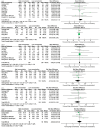Different concentrations of hyaluronic acid eye drops for dry eye syndrome: a systematic review and Meta-analysis
- PMID: 38895674
- PMCID: PMC11144765
- DOI: 10.18240/ijo.2024.06.17
Different concentrations of hyaluronic acid eye drops for dry eye syndrome: a systematic review and Meta-analysis
Abstract
Aim: To compare high or low concentration of hyaluronic acid eye drops (HY) for dry eye syndromes (DES).
Methods: Randomized controlled trials (RCTs) comparing various concentrations of HY were searched in PubMed, Embase, Web of Science, Cochrane, SinoMed, CNKI, Wanfang Database, CQVIP, and Chinese journals databases between inception and July 2023. Pooled standardized mean differences (SMD) or weighted mean difference (WMD) with 95% confidence intervals (CI) from RCTs evaluating Schirmer's I test (SIT), corneal fluorescein staining score (CFS), tear breakup time (TBUT), DES score (DESS), and Ocular Surface Disease Index (OSDI) were calculated. Sensitivity analysis, Egger's test and Meta-regression analysis were performed for all indicators.
Results: We conducted a Meta-analysis of 10 RCTs that met the inclusion criteria, involving 1796 cases. High-concentrations group significantly improved the outcome of CFS according to random effects modelling (SMD, -3.37; 95%CI, -5.25 to -1.48; P=0.0005). The rest of the results were not statistically significant, including indicators such as SIT, TBUT, DESS and OSDI.
Conclusion: For dry eyes with positive corneal staining, a high concentration of HY is recommended, whereas in other cases, a high concentration of HY does not offer a more pronounced advantage over a low concentration of HY in the treatment of dry eyes.
Keywords: Meta-analysis; concentration; dry eye; hyaluronic acid.
International Journal of Ophthalmology Press.
Conflict of interest statement
Conflicts of Interest: Ouyang XW, None; Fang S, None; Yi YM, None; Zou SP, None; Hu QY, None; Huang ZX, None; Li QX, None; Luo JY, None.
Figures










Similar articles
-
Sodium Hyaluronate in the Treatment of Dry Eye Syndrome: A Systematic Review and Meta-Analysis.Sci Rep. 2017 Aug 21;7(1):9013. doi: 10.1038/s41598-017-08534-5. Sci Rep. 2017. PMID: 28827614 Free PMC article.
-
A Meta-Analysis of the Efficacy of Hyaluronic Acid Eye Drops for the Treatment of Dry Eye Syndrome.Int J Environ Res Public Health. 2021 Mar 1;18(5):2383. doi: 10.3390/ijerph18052383. Int J Environ Res Public Health. 2021. PMID: 33804439 Free PMC article. Review.
-
Sodium hyaluronate in the treatment of dry eye after cataract surgery: a meta-analysis.Ann Palliat Med. 2020 May;9(3):927-939. doi: 10.21037/apm-20-695. Epub 2020 May 12. Ann Palliat Med. 2020. PMID: 32434354
-
Autologous serum eye drops for patients with dry eye disease: a systematic review and meta-analysis of randomized controlled trials.Front Med (Lausanne). 2024 Sep 13;11:1430785. doi: 10.3389/fmed.2024.1430785. eCollection 2024. Front Med (Lausanne). 2024. PMID: 39346942 Free PMC article.
-
Autologous Serum Eye Drops versus Artificial Tear Drops for Dry Eye Disease: A Systematic Review and Meta-Analysis of Randomized Controlled Trials.Ophthalmic Res. 2020;63(5):443-451. doi: 10.1159/000505630. Epub 2019 Dec 30. Ophthalmic Res. 2020. PMID: 31884498
References
-
- Carreno-Galeano JT, Dohlman TH, Kim S, Yin J, Dana R. A review of ocular graft-versus-host disease: pathophysiology, clinical presentation and management. Ocul Immunol Inflamm. 2021;29(6):1190–1199. - PubMed
LinkOut - more resources
Full Text Sources
Miscellaneous
